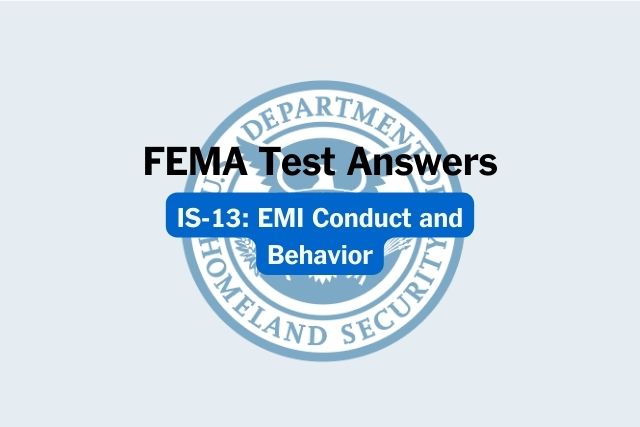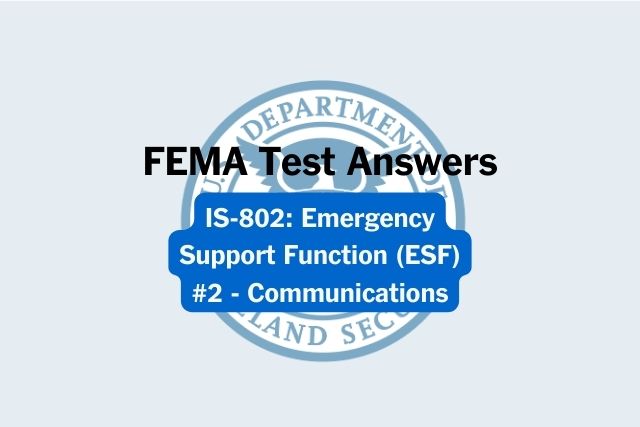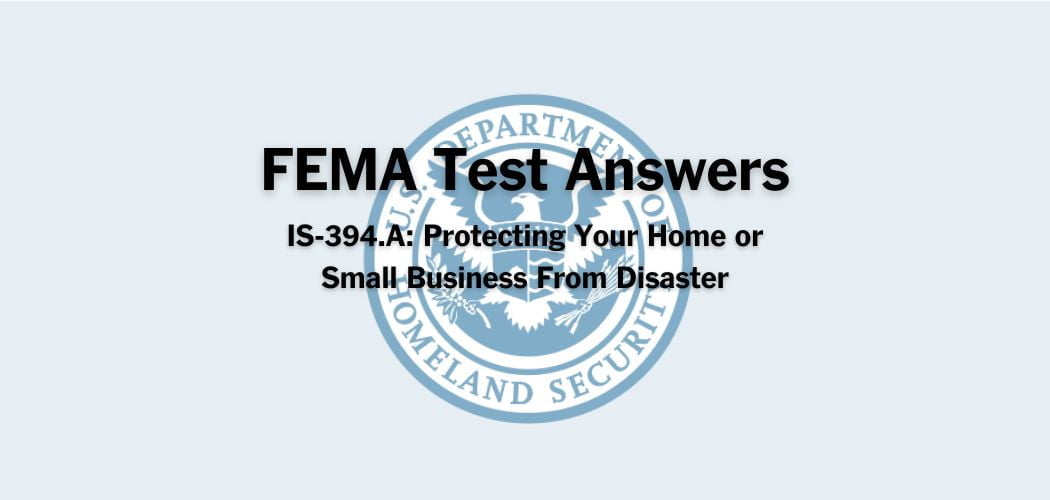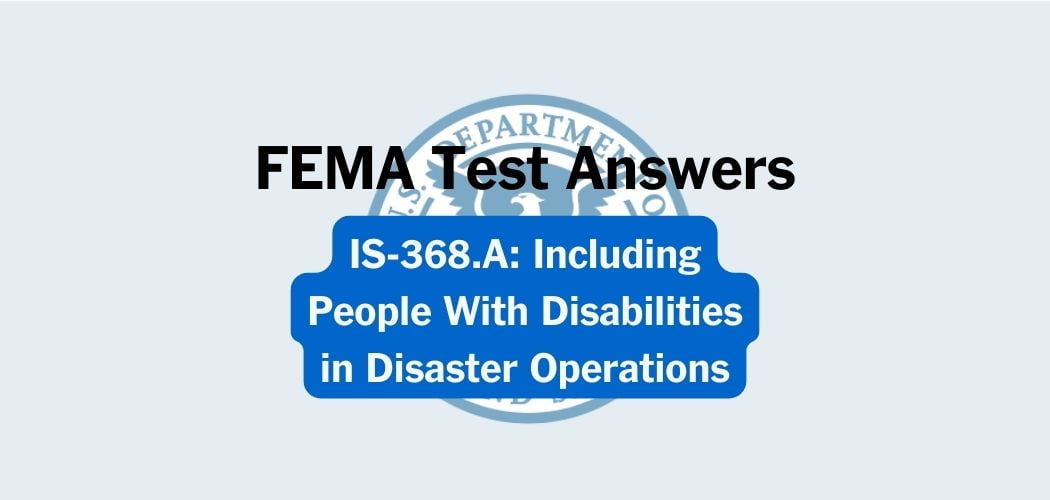Overview: The FEMA IS-1400 course was published on Apr 18, 2024 to provide fundamental instruction for participants to achieve a basic understanding of climate change concepts. Emphasis will be placed on defining common vocabulary and identifying key concepts.
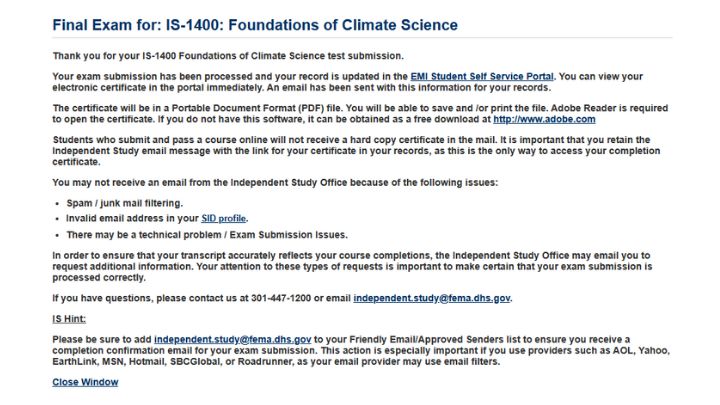
FEMA IS-1400 test answers
Note: Each time this test is loaded, you will receive a unique set of questions and answers. The test questions are scrambled to protect the integrity of the exam.
Question 1. During disasters, what is a crucial action for emergency responders to ensure effective response coordination?
A. Collaborate with various agencies and organizations to coordinate efforts.✅
B. Maintain isolated response efforts to prevent confusion.
C. Delay communication with the public until all details are confirmed.
D. Withhold information to avoid causing panic among the public.
Question 2. How does climate change contribute to the exacerbation of natural disasters such as heatwaves and wildfires?
A. By drying out soil and vegetation due to increased temperatures✅
B. By increasing the time between extreme weather events
C. By decreasing the intensity of hurricanes and typhoons
D. By decreasing global temperatures
Question 3. According to the National Oceanic and Atmospheric Administration (NOAA) report, what was the total cost of billion-dollar disasters in the United States in 2022?
A. $165 billion✅
B. $22.1 billion
C. $2.475 trillion
D. $112.9 billion
Question 4. What is the primary cause of the increase in carbon dioxide levels in Earth’s atmosphere?
A. Burning fossil fuels and releasing greenhouse gases✅
B. Plant respiration
C. Changes in the Earth’s orbit
D. Natural processes such as volcanic eruptions
Question 5. Which principle of equity ensures that emergency information and services are accessible to individuals with disabilities?
A. Accessibility✅
B. Community Engagement
C. Cultural Competence
D. Data Equity
Question 6. What impact does climate variability have on extreme weather events?
A. It increases the frequency and intensity of extreme weather events✅
B. It has no effect on extreme weather events
C. It only influences long-term climate changes
D. It decreases the frequency and intensity of extreme weather events
Question 7. What does resilience refer to in the context of individuals, communities, systems, or organizations?
A. The tendency to succumb to difficulties without resistance
B. The capacity to bounce back and adapt to adversity✅
C. The reliance on external assistance to overcome obstacles
D. The ability to avoid challenges altogether
Question 8. What primarily determines the classification of biomes?
A. Vegetation types✅
B. Atmospheric pressure
C. Soil composition
D. Weather patterns
Question 9. What effect do rising sea levels, caused by climate change, have on coastal areas?
A. Increased risk of flooding and erosion✅
B. Reduced erosion of coastlines
C. Enhanced freshwater sources
D. Decreased risk of flooding
Question 10. What role does community engagement play in building resilience before disasters?
A. It limits the availability of resources for emergency response.
B. It ensures that plans reflect the needs and concerns of all members.✅
C. It obstructs the implementation of early warning systems.
D. It increases vulnerability by spreading panic and fear.
Question 11. What unique challenges do immigrant and refugee communities face during climate-related disasters?
A. Strong infrastructure and housing options
B. Limited English proficiency and barriers in accessing essential services✅
C. Equal employment opportunities compared to native populations
D. High levels of access to healthcare and social services
Question 12. What does equity in emergency management aim to prevent and rectify?
A. Environmental degradation
B. Climate change
C. Ignoring community engagement
D. Social and economic disparities✅
Question 13. Which of the following is an abiotic factor in an ecosystem?
A. Rocks✅
B. Plants
C. Animals
D. Bacteria
Question 14. What does equity in emergency management prioritize?
A. Providing tailored support to address specific needs✅
B. Allocating resources based on favoritism
C. Ignoring existing disparities and inequalities
D. Treating everyone the same regardless of circumstances
Question 15. What are examples of natural causes of climate variability?
A. Land-use changes
B. Changes in solar radiation✅
C. Anthropogenic influences
D. Emission of greenhouse gases
Question 16. Which of the following factors contributes to the vulnerability of underserved communities during climate-related disasters?
A. Economic disparities and limited access to resources✅
B. Strong social networks and community cohesion
C. Extensive infrastructure and technological capabilities
D. High levels of access to resources
Question 17. What is the greenhouse effect?
A. The process of trapping heat near the Earth’s surface✅
B. The process of cooling Earth’s atmosphere
C. The process of converting carbon dioxide into oxygen
D. The process of trapping oxygen near the Earth’s surface
Question 18. What is a recommended action for communities during the recovery phase of emergency management?
A. Utilize hazard insurance to cover all recovery costs
B. Avoid disaster-resilient building codes and standards
C. Implement nature-based solutions and disaster-resilient building codes into recovery plans✅
D. Ignore floodplain management programs
Question 19. What human activity has contributed the most to the increase in carbon dioxide levels in the atmosphere?
A. Industrialization and burning of fossil fuels
B. Rice farming
C. Volcanic eruptions
D. Deforestation
Question 20. What are the primary factors considered by the Köppen climate classification system to determine climate types?
A. Altitude and types of natural disasters✅
B. Type of vegetation and species of animals
C. Temperature and amount of precipitation✅
D. Wind patterns and bodies of water
Question 21. What distinguishes climate from biomes?
A. Climate is only relevant to ecosystems, while biomes affect entire regions.
B. Climate is solely influenced by temperature, while biomes are influenced by precipitation.
C. Climate is determined by biomes, while biomes are determined by climate.
D. Climate focuses on atmospheric processes, while biomes focus on biology and ecology.✅
Question 22. Which aspect of climate variability focuses on differences in climate patterns across different regions?
A. Global variability
B. Seasonal variability
C. Temporal variability
D. Spatial variability✅
Question 23. How does spatial variability in climate affect different regions?
A. It has no impact on regional climate differences
B. It causes identical weather patterns in neighboring regions
C. It leads to uniform climate conditions globally
D. It results in variations in climate patterns among regions at any given time✅
Question 24. What is a key aspect of successful hazard mitigation and community planning?
A. Prioritizing current conditions over future risks
B. Ignoring future conditions
C. Focusing only on historical data
D. Adopting strategies that consider future conditions✅
Question 25. Name the five components of climate.
A. Hydrosphere, Lithosphere, Thermosphere, Atmosphere, and Exosphere
B. Biosphere, Lithosphere, Cryosphere, Atmosphere, and Hydrosphere.✅
C. Atmosphere, Biosphere, Mesosphere, Cryosphere, and Exosphere
D. Thermosphere, Atmosphere, Ionosphere, Cryosphere, and Biosphere
Question 26. How does equity address the allocation of resources during emergencies?
A. By providing equal resources to everyone
B. By allocating resources based on historical data
C. By ignoring existing inequalities
D. By prioritizing proportional allocation based on need and vulnerability✅
Question 27. How many degrees Celcius did the average global temperature change since the mid-20th century according to NASA’s 2023 report?
A. It has increased by 2°C
B. It has decreased by 1.2°C✅
C. It has remained relatively constant
D. It has increased by 1.2°C
